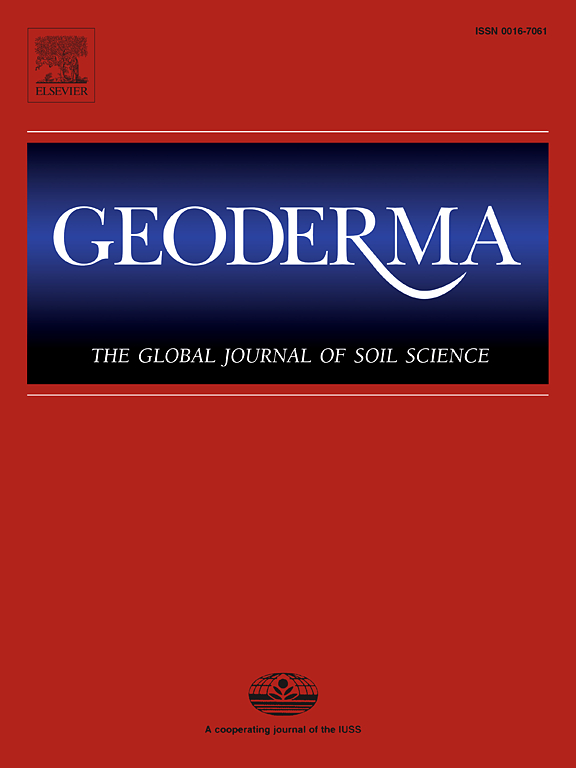土壤矿物质和土壤中硅的溶解作用是由根渗出化合物引起的
IF 6.6
1区 农林科学
Q1 SOIL SCIENCE
引用次数: 0
摘要
有机根渗出化合物(ORECs)可以促进矿物溶解,释放硅(Si),但ORECs诱导不同土壤硅池中硅的溶解过程尚不清楚。本研究探讨了两种羧酸盐(柠檬酸盐、草酸盐)和一种酚酸盐(儿茶酚)对土壤和土壤矿物质中硅的溶解作用的影响。我们提取了6种不同的土壤、7种原生矿物和4种粘土矿物,其中3种ORECs和NH4NO3作为背景电解质(对照),根际浓度为5 mmol L−1。提取液没有经过缓冲以模拟真实根际环境。试验土壤中硅的可提取性与粘土含量呈正相关,而其他土壤化学和矿质特征无明显相关性。在2小时的提取时间内,ORECs从原生矿物、粘土矿物和土壤中提取的Si是对照的11倍。柠檬酸盐持续增加硅在土壤和土壤矿物质中的溶解度。儿茶酚主要增加土壤矿物对硅的溶解作用,而草酸盐在土壤中的作用最大。总体而言,ORECs的硅溶出效率变化很大,并遵循柠檬酸盐和柠檬酸盐的顺序;儿茶酚祝辞草酸盐用于初级矿物,儿茶酚;柠檬酸比;草酸盐用于粘土矿物,草酸盐>;柠檬酸比;土壤中的儿茶酚。我们得出结论,ORECs可以在植物根际观察到的低浓度下强烈增强土壤和土壤矿物质的硅溶解。这些orec诱导的矿物风化过程有助于根际硅动力学,促进土壤形成。本文章由计算机程序翻译,如有差异,请以英文原文为准。
Silicon solubilisation from soil minerals and soil by root exudate compounds
Organic root exudate compounds (ORECs) can enhance mineral dissolution, releasing silicon (Si), but OREC-induced processes of Si solubilisation from different soil Si pools are poorly understood. This study explored the impact of two carboxylates (citrate, oxalate) and a phenolate (catechol) on Si solubilisation from soils and soil minerals. We extracted six different soils, seven primary minerals, and four clay minerals with the three ORECs and NH4NO3 as a background electrolyte (control) at a realistic rhizosphere concentration of 5 mmol L−1. The extraction solutions were not buffered to mimic the conditions of real rhizospheres. Silicon extractability from the experimental soils was positively related to clay content, whereas other soil chemical and mineral characteristics showed no obvious relation. The ORECs extracted up to 11 times more Si than the control from primary minerals, clay minerals and soils during 2-hour extraction periods. Citrate consistently increased Si solubility in soils and soil minerals. Catechol mainly increased Si solubilisation from soil minerals, while oxalate had the greatest effect in soils. Overall, the Si solubilisation efficiency of ORECs varied and followed the order citrate > catechol > oxalate for primary minerals, catechol > citrate > oxalate for clay minerals, and oxalate > citrate > catechol for soils. We conclude that ORECs can strongly enhance Si solubilisation from soils and soil minerals at concentrations as low as observed in plant rhizospheres. These OREC-induced mineral weathering processes contribute to Si dynamics in the rhizosphere and facilitate soil formation.
求助全文
通过发布文献求助,成功后即可免费获取论文全文。
去求助
来源期刊

Geoderma
农林科学-土壤科学
CiteScore
11.80
自引率
6.60%
发文量
597
审稿时长
58 days
期刊介绍:
Geoderma - the global journal of soil science - welcomes authors, readers and soil research from all parts of the world, encourages worldwide soil studies, and embraces all aspects of soil science and its associated pedagogy. The journal particularly welcomes interdisciplinary work focusing on dynamic soil processes and functions across space and time.
 求助内容:
求助内容: 应助结果提醒方式:
应助结果提醒方式:


